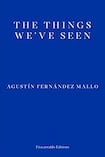
If you reach a point in a novel when a sentence such as “with eighteen placenta-Marlboro cigarettes to go, I lit the third and waited patiently to pass out again” makes complete sense then you must already have read many pages of imaginative construction and the careful creation of a fictional context in which the limits of reality are extended.
At first, the life of the writer/narrator of The Things We’ve Seen seems privileged, if unremarkable. He is invited to take part in a symposium about digital networks on an island called San Simón, off the coast of Spain. Although he attends, the live-streamed discussions are of marginal interest. Indeed, he demonstrates some hostility to the other people taking part.
Of far more interest is his quest to locate traces of the island’s past use as a prison, in the post-civil war era, for those who fought on the anti-fascist side. He has a book which includes a number of photographs of prisoners taken at various locations around the island. He seeks out those precise places and, whenever he finds one, photographs it. Both the older and most recent photos are included in Agustín Fernández Mallo’s novel.
The duration of the conference does not give the narrator enough time to pursue this compulsion. Having returned to the mainland, he arranges to be brought to the now deserted (or is it?) island to continue to understand and uncover the history of that time. In doing so, he begins to uncover one of the recurring propositions of the novel: that seeing and understanding are separate matters.
While on the island he gets a text message telling him: “It’s a mistake to take the things we’ve seen as given.” This same message recurs several times in the novel, to other characters experiencing very different situations, but always pointing to the essential disorientation of our most personal endeavours. The low hum that is always audible.
They, like us all, drag their memories and connections along with them wherever they go, filtering everything through their particular consciousness
With a jolt, we are with the writer in New York, where he meets an artist whose video work immediately intrigues him because it includes images from San Simón. The sequence of connections that result from meeting this woman and several other characters chanced upon in incidental encounters have a dream-like quality; the pre-waking weirdness of associations between what is apparently known and what is unattainable.
In this second part, the author appears to work through association and improvisation. Non-sequiturs abound, as unpredictable as they are compelling, building our ability to accept wild inventions and accepting as plausible a baker whose in-demand biscuits in the shape of a pregnant dog are made from human breast milk.
The story of that baker and his role on the island increasingly gains importance, as does the poetry of Lorca, resulting in a trip to Uruguay by the narrator and the video artist. We, and the characters, have come a long way. They, like us all, drag their memories and connections along with them wherever they go, filtering everything through their particular consciousness.
Having concluded Book I of the novel, we hear no more of the narrator until his partner recounts aspects of their life together in Book III. Book II concerns the afterlife of the fourth astronaut on Apollo 11. He cannot be seen in any of the photos because it was he who was holding the camera, he tells us. Having received little adulation on his return to Earth, he now works at an old people’s home, in Florida.
Yes! Mallo's imagination never falters
But there are no limits to the conjecture a person can engage in, no matter what their daily reality. Already, in Book I, Mallo has demonstrated a wildly discursive, apparently disconnected form of narrative (including retelling a story by Jeffrey Eugenides) which continues here, culminating in a series of messages from the former astronaut’s deceased mother found in the vomit of George Bush snr. Yes!
Mallo’s imagination never falters. To stay with him means loosening all limitations we might wish to impose on a text. The reward is an audacious adventure.
Book III is somewhat more conventional. A woman walks through Normandy, revisiting areas she once holidayed in with the narrator of Book I. This section pursues one of the preoccupations of the novel, which is that the dead, at a molecular level, are always with us.
Another theory, proposed by the host of a B&B where the woman stays for a night, is that WG Sebald’s The Rings of Saturn is a fractal work because it never proceeds in a linear fashion. This is surely true of this novel too. As her host tells her: “That’s the greatness of all good literature, not only can it make us see things that don’t exist, but things we’d be hard-pressed to even dream up.”
This is, indeed, a dream of a book.








